THE KALINGA BATOK (TATTOO) FESTIVAL
Article © 2009 Lars Krutak
October is indigenous people's month in
the Philippines and in the northern province
of Kalinga local organizers in the city of
Tabuk, the capital of the province, hosted a
Diddiga ("pride") celebration to mark the
accomplishments of the Kalinga people. This
year's four-day event was themed "Pride of
the Past - Hope for the Future" and
showcased the beauty of Kalinga culture
through a music and dance competition (Sallidummay),
a Chico River rafting experience (the "river
of life" in Kalinga), and on the final day a
Batok (tattoo) Festival that tattooed
Kalinga elder and provincial officer of the
National Commission on Indigenous Peoples (NCIP)
Miss Naty Sugguiyao suggested "expresses
through individual talent, arts, prowess,
and strength... the very best of Kalinga."
|
|
The purpose of the Batok Festival was not only to celebrate the
artistic achievements of Kalinga tattoo artists and the beautifully
adorned men and women in attendance, but to also recognize that this
ancient 1,000 year-old cultural practice is vanishing along with the
gatekeepers of knowledge associated with it. Fifty-two elders from
remote highland communities and the Tabuk area visited the event
including the last Kalinga mambabatok or tattoo artist - the graceful
89-year-old Whang Od. She along with California-based Elle Festin, Zel,
and Gyroe of Tatak Ng Apat Na Alon ("Mark of the Four Waves Tribe")
demonstrated the ancient hand-tapping art of batok for all to
experience. Elle also got the mayor of Tabuk (Camilio T. Lammawin, Jr.)
involved by inking his first tattoos - traditional Kalinga designs on
his wrists. |
To promote the event, the Governor Floydelia R. Diasen drafted an
executive order encouraging the participation of the entire province to
observe indigenous month with the Diddiga as its highlight. It stated
that this celebration is "meant to engender the Kalinga's pride of
identity [and] to enrich their foundation to stand on their own
ethnicity anchoring their dreams and aspiration to the positive dynamic
aspect of culture and time tested traditions." In her speech to the vast
crowds that were present she stated: "We must not shy away from the
lessons we have learned in the old days and let us be proud of our
ethnic roots for its from looking back into who we once were that we
become more enlightened with where and who we must be in the future."
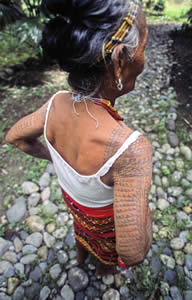 |
|
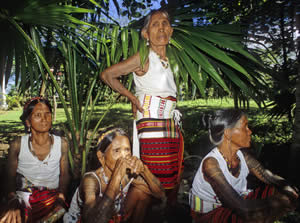 |
|
Beautiful fern design
tattoos on the back of an elder
Kalinga woman's arm - a centipede
crawls across her shoulder. |
|
Tattooed Kalinga women waiting for a portrait at the Batok Festival.
|
|
The Kalinga Batok Book Project
The Batok Festival also served as a
platform from which to spearhead another
historical event in Kalinga - the start of a
book project focusing on the unique art form
of Kalinga tattoo. With the help of
Manila-based photographer Ivan Sarenas, Ned
Sickles a professional photographer and
cameraman from the United States, and
funding provided by the Daniele Agostino
Derossi Foundation, our research team was
able to photograph all of the tattooed
elders in our midst for the forthcoming
Voices of the Ancestors: The Living
Tradition of Kalinga Tattoo book. But let me
also not forget to mention that our esteemed
colleague and friend Travelin' Mick (Michael
Laukien) is also contributing some of his
superb Kalinga images to the project as well
- making this a truly international and
collaborative affair!
The goal of the "batok team" is to
produce a beautifully illustrated, bilingual
(English/Kalinga), medium to large format
book joining the photographic images of the
tattooed Kalinga elders to their voices
(e.g., oral histories) and Kalinga
myths/legends to comprehend the complex
meanings behind their intricately beautiful
tattoos. It will be fully referenced,
indexed, and will include a glossary of
Kalinga tattoo terminology. Voices of the
Ancestors will be the first book to tell the
story of Kalinga batok, the first book to
shed light on an incredibly rich cultural
tradition that has graced the bodies of the
Kalinga since they arrived in this remote
corner of the Philippines.
After the Batok Festival, we built upon
previous research in the region (e.g., In
2007, some of us stayed in the village of
Buscalan for three weeks where the last
Kalinga tattoo artist Whand Od is from) and
trekked to seven villages interviewing
tattooed elders and local historians about
the rich tradition of this largely
unrecognized art form. This research is of
an urgent nature since there are less than
two-hundred Kalinga elders that retain their
full-body tattoos, and of these less than
thirty Kalinga warriors remain: each of
which were marked for their exploits against
Japanese forces during WWII. Some of these
veterans fought alongside U.S. soldiers in
the dense and mountainous jungles of Kalinga
Province and this story has largely been
forgotten.
After my departure from the Philippines,
two Kalinga research teams under the
direction of project co-supervisor Naty
Sugguiyao travelled to more villages in
regions that have not yet been visited. They
also revisited other areas to follow-up with
some of the Festival attendees or interview
elders who could not make the trip to Tabuk.
The research teams will cover the entire
Kalinga region since there are regional
variations, meanings, and stories associated
with tattoo motifs and methods of tattoo
application. For example, the diversity of
Kalinga tattoo meanings and designs is quite
amazing since villages next to one another
may have different names associated with
particular tattoo motifs even though they
appear to be the same designs. But designs
such as rice bundles, steps to rice
terraces, fern designs, rattan fruits,
python snake scales, and centipede motifs
have one thing in common - they are all
derived from nature.
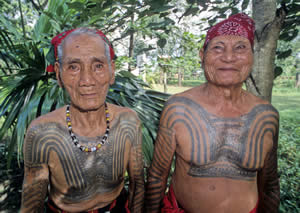 |
|
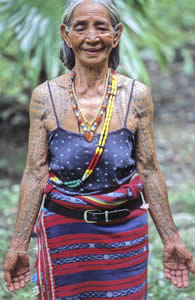 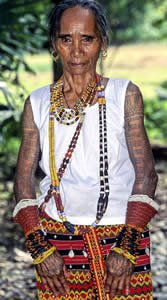 |
|
The only two Kalinga
men who attended the Batok Festival
are two "best friends" - Pedro
Bangiak (necklace) and our favorite
big "Uncle George" Casing. Both were
marked for their victories over
Japanese soldiers in WWII. Sadly,
the number of Kalinga WWII veterans
is decreasing each year. |
|
Left) Heavily tattooed arms
and beaded bodies make for timeless
beauty at the Batok Festival!
Right) The beautiful bead ensembles circling the wrists of this Kalinga woman are called tinali.
|
|
|
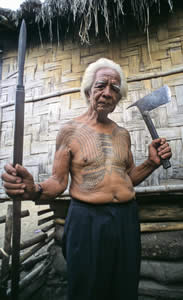
|
|
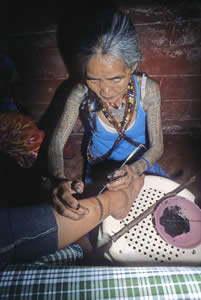 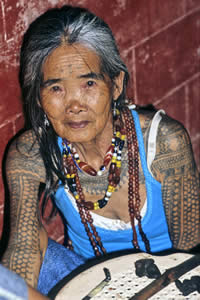 |
|
Jaime Alos, one the
last tattooed warriors of the
Dananao Kalinga, displaying
traditional headhunting weapons: the
spear and head-ax. The designs in
the center of his chest (bridging
his sternum) were believed to "block
the pathway of his enemy." The
protuberances arching outwards above
his navel are the horns of the
carabao; a symbol of a "war leader."
The "V" connecting the horns
symbolizes "victory" he said. | |
The Last Kalinga
tattooist Whang Od hand-tapping a
new design on Elaine Tima in a dark
back room at the Batok Festival. She
uses the rear-end of her kisi or
tattooing tool to stencil the
design. The kisi consists of a piece
of carabao (water buffalo) horn bent
by fire resembling the letter "L"
holding a row of four or five
razor-sharp thorns or needles in its
head. Elaine's father is a noted
Kalinga anthropologist. At other
times, Whang Od uses an orange thorn
attached to a small bamboo stick to
make her tattoos. |
The Meaning of Kalinga Batok
Kalinga tattooing is an
important vehicle for expressing and
reinforcing the psychological dimensions of
life, health, warfare, religion, and death.
It is a cultural practice deeply rooted
within the memory of the Kalinga's ancestral
life and embodies personal, social,
ecological, and metaphysical values through
a wide array of visual tattoo symbolism.
Kalinga batok functions to
communicate the shared values within the
group and tells others what the ethos of the
Kalinga is and what sensibilities were
shaped by that cultural world. As a system
of knowledge transmission, batok works to
assert and inscribe tribal affiliation,
maturity, status, as well as Kalinga
cultural pride and artistic ability. For
89-year-old Whang Od, the last Kalinga
tattoo artist, she has transformed countless
generations of Kalinga "boys" and "girls"
into "men" and "women" through severely
painful rites of passage with her orange
thorn needle and wooden mallet. She has also
created tattoos that are believed to induce
fertility, and others that enabled warriors
to defeat their enemies or protect
individuals from unseen enemies or illnesses
borne from marauding evil spirits.
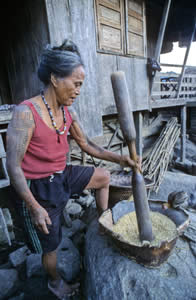
Pounding rice at dawn.
|
|
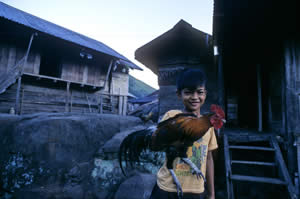 |
|
A
favorite pet, Lubo village |
The
anticipated publication date of Voices of
the Ancestors is spring 2010. But because
the cost of printing books of this size and
quality is high, we continue to seek
additional funding to pay for the printing.
If you want to make a contribution to the
publication fund, please contact The
Kalingas-North America Network (KaNA) who is
our U.S.-based nonprofit sponsor in Los
Angeles, California. All gifts through KaNA
for the publication are tax-deductable. You
may contact the organization's Chief
Executive Officer Mr. Marshalfield A. Wandag
at (323) 286-9281 or e-mail via:
kananetwork@sbcglobal.net If you
have any additional questions, you can also
write me at:
bodymarks@larskrutak.com
Museum photo gallery of these images may be seen here.
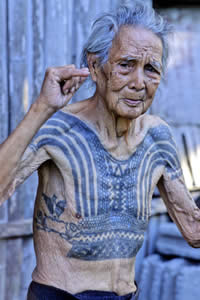 |
|
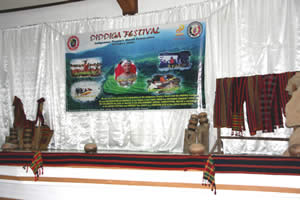 |
| The Old Lubo warrior
(mingor) and former police chief
Candido Baliyao. The eagle designs
on his sides originated with coins
minted during the American
Commonwealth period (1935-1946).
When taken together, however, his
entire chest tattoo (bikking)
represents in abstract form the
outstretched wings of the eagle. |
|
Festival stage decorated with
Kalinga folk arts. Photograph
courtesy of Chico River Quest.com. |
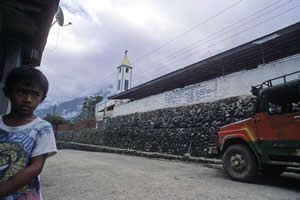
Missionization,
roads, and communication with the
outside world have all played a part
in the demise of Kalinga tattooing
customs. |
|
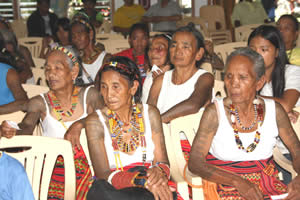
Tattooed elders look
on at the Batok Festival. Whang Od
sits at far right. Photograph
courtesy of Chico River Quest.com. |
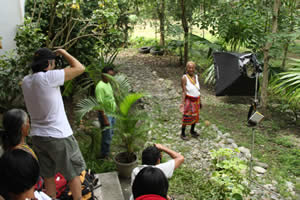
Author and Ivan
Sarenas imaging Kalinga elders for
the Voices of the Ancestors project. |
|
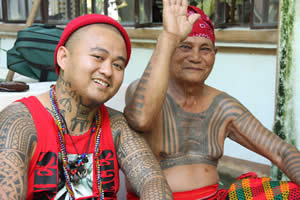
Elle Festin and Uncle
George sharing stories at the Batok
Festival. Photograph courtesy of
Chico River Quest.com. |
Museum photo gallery of these images may be seen here. |
















